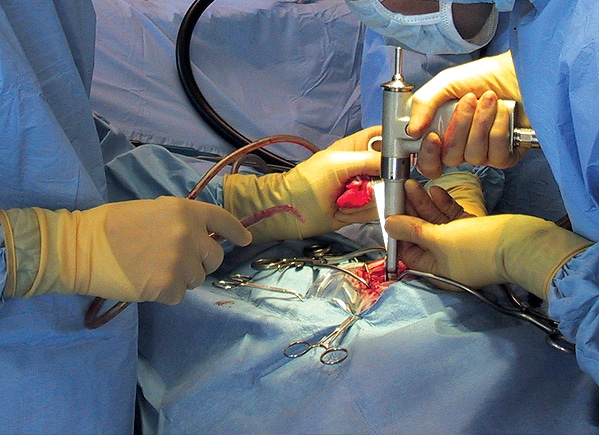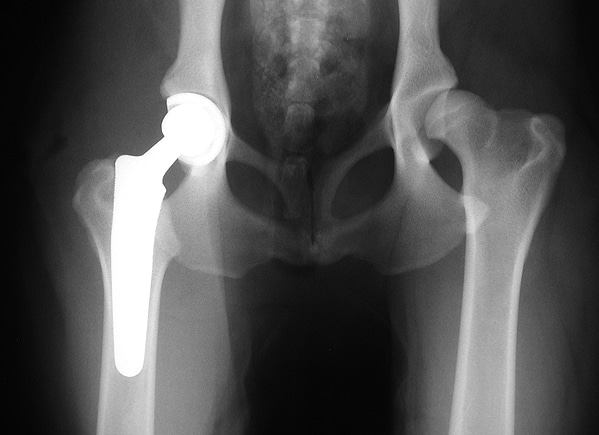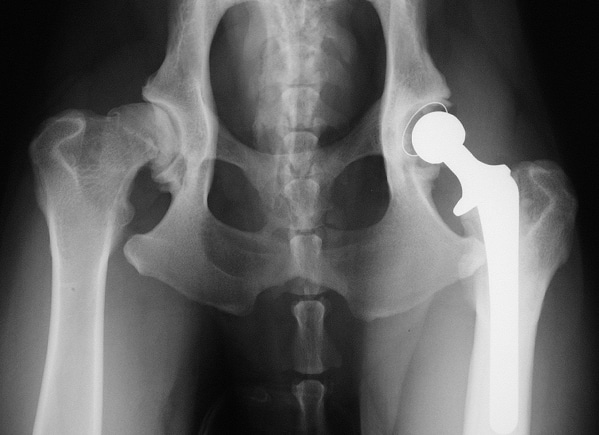
Does my dog need a total hip replacement?
Total hip replacement (THR) surgery is a major procedure with possible complications. As a result it is only performed in dogs and cats where the benefits of surgery outweigh the possible risks and where alternative methods of treatment are less successful.
THR surgery is primarily performed in medium, large and giant dogs, however, it may also be performed in small dogs and cats.
Candidates for THR surgery are dogs and cats with persistently painful hips that are not responding satisfactorily to medical management, including exercise restriction, weight control and judicious use of pain killers. Signs of hip pain include difficulty rising and jumping, stiffness, lameness, restlessness, and reluctance to exercise and play. The most common cause of hip joint pain is osteoarthritis associated with hip dysplasia. This can affect dogs as young as six months of age. Other indications for THR surgery include dislocation (luxation) of the hip and fractures of the hip joint. (See also Hip Dysplasia Information Sheet)
Are there any contraindications to THR surgery?
Dogs with hip dysplasia / osteoarthritis, no matter how severe, are not candidates for THR surgery if signs of pain and lameness are mild and readily controlled by conservative measures.
Candidates for THR surgery must be in good general health. Blood tests may be recommended to ensure that internal organs, for example the liver and kidneys, are working properly and that the blood cells are normal.
It is important that the dog or cat has no general infections, for example of the skin (pyoderma), and that the hip joint to be replaced is not infected. If there is any doubt regarding the latter it may be necessary to collect a sample of fluid from the joint for laboratory analysis. Any previous major surgery on the hip, for example to repair a dislocation or fracture, may increase the possibility of complications with THR surgery. In general, animals who have already had the femoral head removed (excisional arthroplasty) are not suitable for hip replacement surgery, although there are occasional exceptions. Where possible the dog or cat should be at least 10 months of age (skeletally mature) at the time of surgery. There is no upper age limit.
What types of total hip replacements are available?
Cemented and cementless THRs are available. With the cemented system the artificial cup and ball (acetabular and femoral prostheses) are held in the pelvis and thigh bone (femur) by bone cement. With the cementless system the prostheses are secured in the bones by what is referred to as a ‘press-fit’ so that the bone in contact with the prostheses can grow into the small pores on their surface. There are pros and cons of the two systems. One limitation of the cementless system is that it is not made for medium and small dogs or cats.v
There are a number of manufactures of THR prostheses for dogs. We use BioMedtrix, an American company, whose prostheses are of the highest quality and whose cemented and cementless systems are completely modular. This means they fit a wide variety of sizes and shapes of dogs and cats and the two systems may be used in the same patient, for example, some dogs may have a cementless cup and a cemented femoral stem.
What does THR surgery involve?
Dogs and cats have to be evaluated to see if they are suitable candidates for THR surgery.
This is done on a separate day to the surgery; often a few weeks before. The first step is to ‘measure’ the patient for the prostheses. This requires obtaining very specific X-rays (radiographs) of the pelvis and thigh bone (femur) and placing them against line drawings (templates) of the various sizes of prostheses available.
Your pet will usually be admitted the day before the surgery. He or she may be fed that morning and water should not be withheld.

Joint replacements are amongst the most challenging operations performed
The surgery
Joint replacements are amongst the most challenging operations performed by veterinary orthopaedic surgeons. A team of two or three surgeons and a nurse are involved. The operating theatre and a vast array of surgical instruments are prepared the day before.
The operation is performed through a relatively small incision directly over the hip. Careful preparation of the hip socket (acetabulum) and top of the thigh bone (femoral canal) is necessary prior to placement of the relevant cemented or cementless prostheses. The two artificial components are then brought together (reduced) and the stability of the hip checked. The thick capsule that surrounds the joint is carefully stitched (sutured) prior to closure of the rest of the wound.
Radiographs are obtained at the end of the operation to check the position of the prostheses. Occasionally a sling is applied to the limb for one or two weeks to prevent weight-bearing until the sutured tissues have time to heal.

A cemented total hip replacement A cementless total hip replacement

A cementless total hip replacement
Aftercare
Aftercare following THR surgery is very important with rehabilitation taking many months. Courses of painkillers and antibiotics are prescribed at discharge. If your pet tends to excessively lick the wound it may be necessary to use a plastic Elizabethan collar. Visits to your own veterinary surgeon are necessary within the first two weeks to check the wound and remove any sutures.
Exercise must be very restricted for the first few weeks until the joint capsule and other soft tissues heal. This is the period when dislocation (luxation) of the prostheses is most likely. Exercise is primarily for toileting purposes. It must be on a lead or harness to prevent strenuous activity, such as chasing a squirrel. At other times, confinement to a pen or a small room in the house is necessary with avoidance of jumping and climbing. After a few weeks, exercise may be gradually increased in a controlled manner (still on a lead). Hydrotherapy may be recommended.
The first check-up at Willows is one month after the operation. Limb and hip function are evaluated at this time. Depending on progress, advice is given regarding increasing exercise. The next check-up is three months following surgery when radiographs are obtained to evaluate the THR. The position of the prostheses and the bone surrounding the cement and prostheses are checked and compared to the radiographs obtained immediately following surgery. This enables stability of the prostheses to be assessed. Further advice is given regarding exercise. Clinical and radiographic examination is recommended one year following THR surgery and annually thereafter.
Risks and complications
The success rate of THR surgery in dogs and cats is high, with over 90% of cases having excellent limb function. However, there are potential complications of which the most common is dislocation (luxation) of the prostheses. This generally occurs within the first few weeks of surgery and often requires a second operation to reduce the dislocation. Less common complications include loosening of the prostheses, fracture of the femur and infection.
Conclusion
The success rate of total hip replacement surgery in dogs and cats is high, and the majority of patients do very well after their operation. It is undoubtedly a major undertaking, but the procedure is one which is commonly performed at North Downs Specialist Referrals. We will be pleased to give as much help and support as possible if you decide to give your pet the opportunity of THR surgery.
If you have any queries or concerns, please do not hesitate to contact us.
Arranging a referral for your pet
If you would like to refer your pet to see one of our Specialists please visit our Arranging a Referral page.